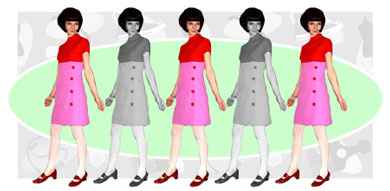Empire waist

Fashion Synopsis
60’s eclecticism created and revitalized many different styles of dress, and the age-old empire line became the freshest look of the ‘baby’ days of the adolescent revival. The empire waist dates back to ancient Greece and Rome, where the style was one of the first fitting measures used for women in the bulky, sheet-like togas.
The tight, nipped-in waists that dominated the 50’s dissolved into to the straight sheath and new ways of fitting. The shift’s style continued to evolve as hems narrowed and widened, and fitting devices raised and lowered. The empire line brought the responsibility of fit to the bustline: instead of the tight bust darts that were common to the shift, the fitting was done in a separation right below the bustline. A tight bustband (think of it as a very high waistband) highlighted the bosom and allowed the dress to drop loosely from the bustline.
The empire style was copied from the fluid garments of the ancients, when ladies wrapped ribbons below their bustline to show off the bosom, and to create fit in the loose togas. The name comes from its revival during the 18th and 19th century. The style, also called the directoire, was the vogue at the end of the 1700’s during the French Directory period, and carried on through the Revolution. Empress Josephine also popularized the style during her husband Napoleon’s reign.
The 60’s love of childhood celebrated the empire waist. Cute baby blue and pink ginghams were a popular print to heighten the child-like form, and adult women embraced the high style as a return to the carefree days of adolescence. The fluid skirts that spread out from the bustline alluded to freedom and gaiety, and so were adopted by the hippies as well. The empire waist then became the style associated with the granny looks of the 70's, but it still makes reappearances every now and then, especially around prom time.
